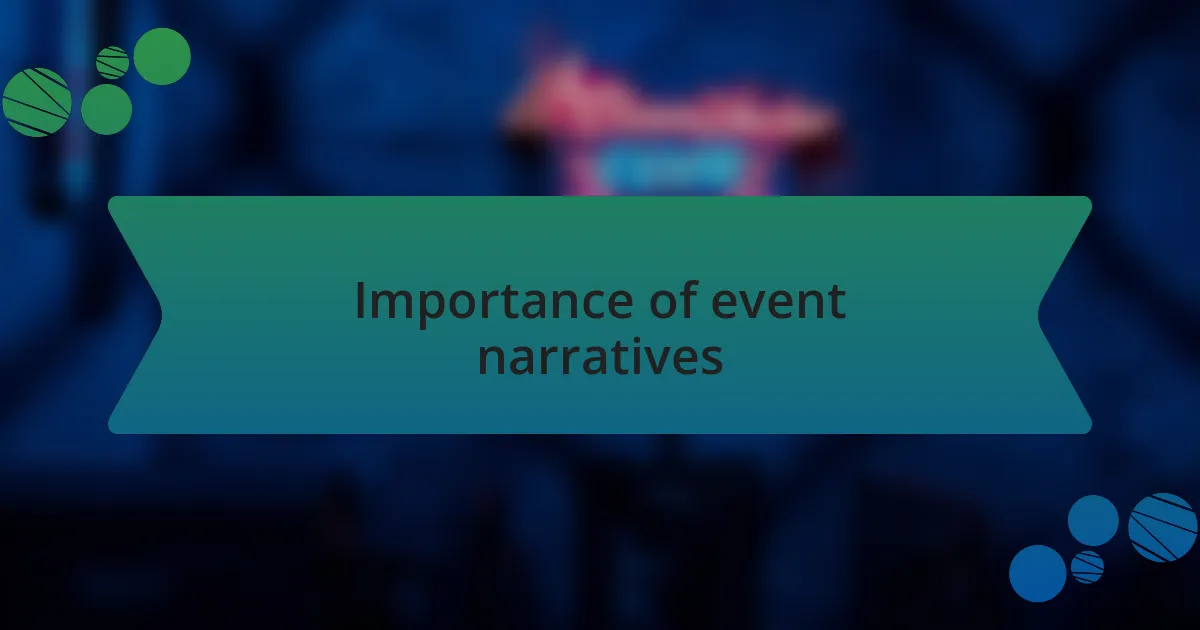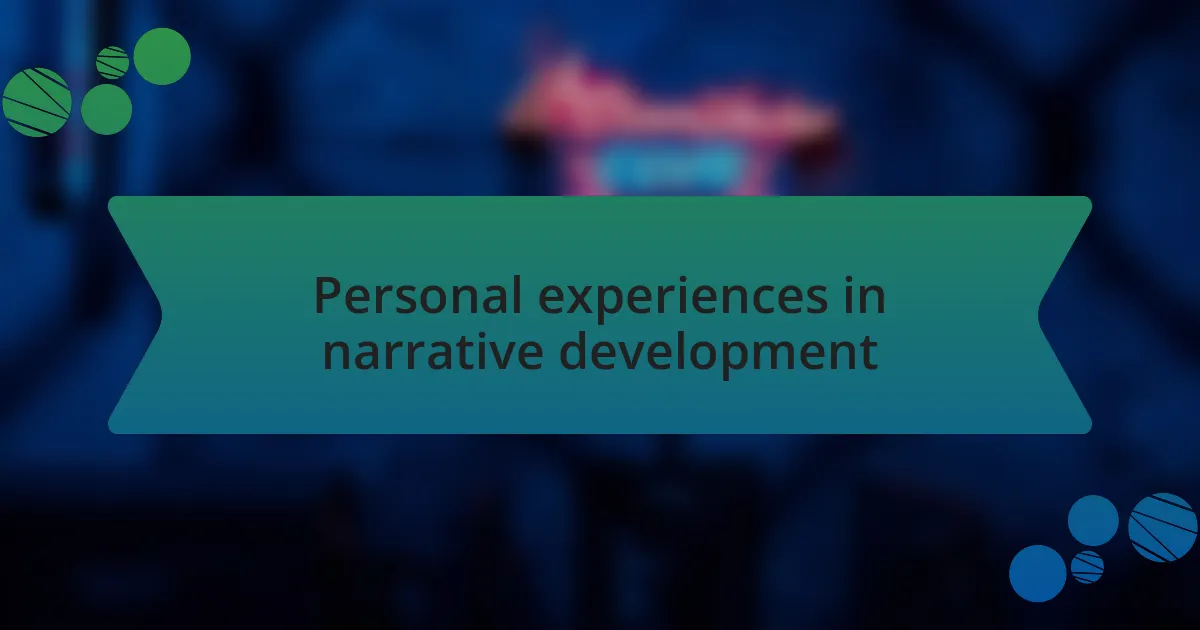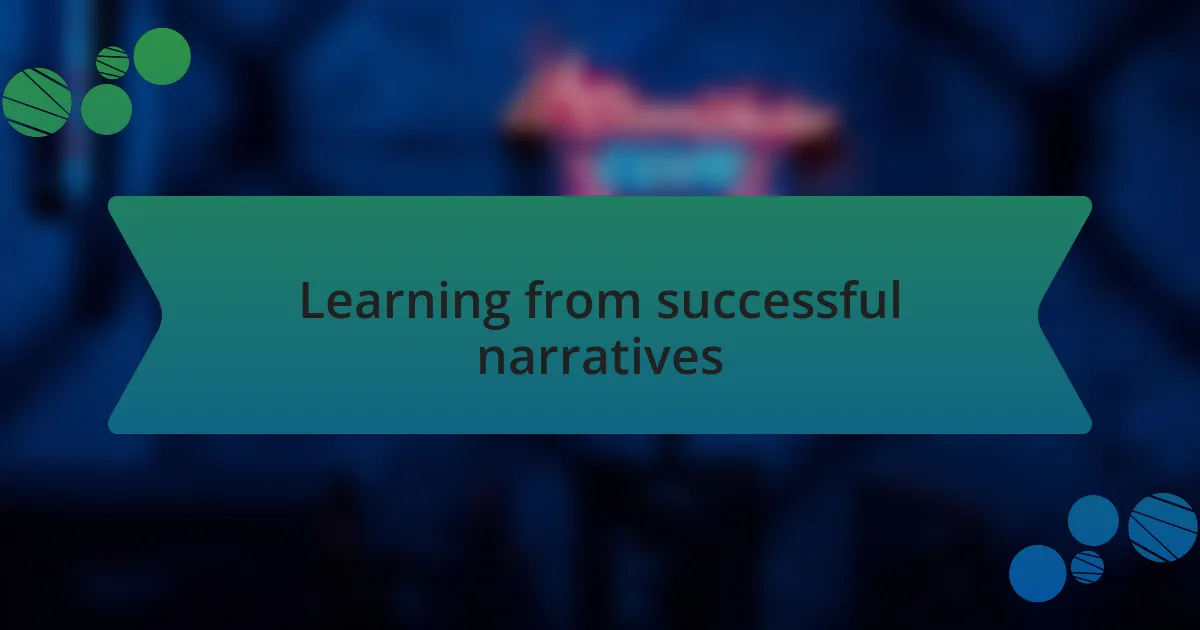Key takeaways:
- Event narratives shape the emotional journey of the audience, making each event memorable and immersive through connection and storytelling.
- A well-developed narrative fosters community, transforming individual experiences into shared connections among attendees.
- Engaging storytelling techniques, such as vivid imagery and personal artist stories, enhance the event atmosphere and deepen audience involvement.
- Successful narratives often feature cohesive themes, offering holistic experiences that resonate emotionally and inspire meaningful conversations post-event.

Understanding event narratives
Understanding the essence of an event narrative is crucial for creating a memorable experience. Imagine being at a festival where every beat of the music resonates with the story being told on stage. Can you feel the energy shift as the crowd connects with the narrative woven into the performance? That’s the power of a strong event narrative—it shapes the audience’s emotional journey.
Every event, whether it’s a small club night or a massive music festival, has its own unique story. I once attended an underground electronic music event where the narrative revolved around exploring new sounds and breaking boundaries. The set design, lighting, and even the DJ’s track selection contributed to a cohesive experience that transported us to another world. This showcases how every detail matters in crafting an immersive narrative.
When thinking about your event narrative, consider what emotions you want to evoke. Do you want to inspire joy, nostalgia, or perhaps a sense of unity among strangers? Reflecting on these elements helps in creating a narrative that resonates deeply with your audience. Ultimately, an impactful event narrative is about connecting with people on a personal level, making them feel like they are part of something larger than themselves.

Importance of event narratives
An event narrative isn’t just a backdrop; it’s the heartbeat of the experience. I remember attending a techno festival where the organizers crafted a story around “rebirth through music.” As we followed the visual journey with each DJ, the atmosphere felt charged, almost spiritual. This narrative choice created a space where everyone connected, breathing in the same transformative energy.
The importance of a well-developed narrative lies in its ability to foster community. At a recent gathering I hosted, I focused on the theme of “connection in isolation.” As we built the event around this, I saw attendees who were strangers become friends, united by the shared experience of dance and sound. It was incredible to witness how a thoughtful narrative can turn a simple party into a profound connection among people.
Moreover, a compelling event narrative gives direction to all planning aspects—from marketing to set design. When I worked on a project emphasizing “the journey of sound,” we incorporated immersive visual elements that reflected this theme. Everything, from the promotional materials to the ambiance, told a cohesive story, which helped draw in a larger audience eager to join the experience. Isn’t it fascinating how a strong narrative can not only enhance the event but also broaden its reach?

Techniques for engaging storytelling
Crafting an engaging event narrative often involves using vivid imagery and sensory experiences that transport your audience into the heart of the story. I recall a night when we themed our event “A Journey Through Soundscapes.” We had bright projections creating a surreal landscape that felt alive, pulling attendees deeper into the experience. How did it feel? Each beat vibrated through the crowd, amplifying the connection to the visuals, making the story not just something you hear, but something you feel.
Character development can also be a powerful technique. For a festival I coordinated, we introduced personal stories from each DJ about how they connected with electronic music. Sharing these narratives beforehand created anticipation and gave depth to their sets. I noticed people exchanging thoughts and stories about their own musical journeys, enhancing the overall sense of community. Does that make the experience richer? Absolutely, as the audience finds their own reflections within the shared narrative.
Building suspense through pacing can keep people engaged from beginning to end. At a show I attended with a slow build-up, the DJ layer upon layer of sound created a mesmerizing tension, which kept everyone dancing but also yearning for that moment when everything would explode. It was an exhilarating release when it finally happened, reinforcing the narrative arc. Isn’t it amazing how pacing can transform the emotional landscape of an event? When done right, it leaves attendees craving not just the music, but the entire story it tells.

Personal experiences in narrative development
In my own journey of developing event narratives, I often draw inspiration from the atmosphere of the venue itself. I recall a smaller underground rave where the dim lighting and intimate setting shaped the entire experience. The energy in that space told a story of its own; each corner held an unwritten narrative. Isn’t it fascinating how a simple venue can influence the emotional tone of an event? It reminds me that the environment is an essential character in our storytelling.
I also find that engaging with the artists personally can dramatically enhance the narrative. Just last summer, I had a heart-to-heart with a local producer who shared his struggles and triumphs encoded in his music. His insights inspired me to weave his story into the promotional material for his set. When he took the stage, I could feel the audience connect deeply with his journey, which transformed that night from just another gig into a shared experience of resilience. How does one person’s story elevate the entire event? It’s all about creating connections.
Another element I’ve found crucial is the role of audience interaction. At a recent festival, I introduced a live feedback segment where attendees could share their thoughts on each set. This not only broke the fourth wall but also built a sense of ownership among the participants. Suddenly, they weren’t just listeners; they were co-authors in the event’s narrative. Have you ever felt that collective energy where everyone becomes part of the experience? It’s a powerful reminder that storytelling in events is not just about the creators but also about the community that breathes life into it.

Learning from successful narratives
Successful narratives often showcase the power of a thematic thread that resonates with an audience. I once attended an event where the theme was ‘rebirth,’ perfectly complemented by the artists’ sets and visual displays. As the night progressed, the music evolved from dark and heavy to uplifting and euphoric. It made me realize how a cohesive theme can elevate an experience, encouraging attendees to connect with it on a deeper emotional level. Have you ever noticed how a unifying theme can carry you through a journey?
Another inspiring example of effective storytelling comes from a festival known for its immersive experiences. I remember how the organizers crafted the entire setting—from lighting to stage design—around the idea of an intergalactic voyage. Every detail, including the ambient sounds between sets, worked together to transport us into another world. This attention to detail reinforced that good narratives are not just about words; they’re about creating a holistic experience that envelops the audience. Isn’t it striking how every element can contribute to a singular narrative arc?
I often reflect on the impact of narratives that highlight social causes. A recent event spotlighted mental health awareness, featuring artists who shared their personal stories with mental health struggles. Hearing these profound narratives not only connected the audience with the performers but also sparked meaningful conversations among attendees long after the event ended. It begs the question, how can we use narratives to foster awareness and change? In my experience, narratives rooted in authenticity often resonate most powerfully with audiences, turning mere entertainment into a catalyst for social impact.